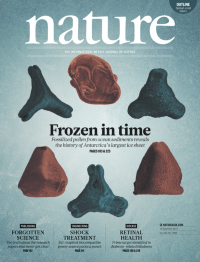Volume 552
-
No. 7685 21 December 2017
As 2017 draws to a close, we once again select âNatureâs 10â â ten scientists whose work this year has had an important impact in their respective fields. The cover design is a nod to the increasingly important role AI has played for business, health care and in science during this year. The image was created using a machine learning algorithm called the travelling salesman problem (TSP), which finds the optimum path between a set of points on a single path. Thus, our â10â is created using only one line. Image by Martin Krzywinski.
-
No. 7684 14 December 2017
The cover shows a selection of fossilized pollen from sediment cores collected from East Antarcticaâs continental shelf. These ancient remains were used by Sean Gulick, Amelia Shevenell and their colleagues to help date sediments eroded from the Aurora Subglacial Basin and document the evolution of the East Antarctic Ice Sheet over the past 55 million years. The teamâs marine geological record indicates that before 7 million years ago, the ice sheet behaved dynamically and was characterized by substantial surface meltwater, much like todayâs Greenland Ice Sheet. This behaviour occurred when temperatures and atmospheric CO2 levels were similar to and higher than present â climate conditions expected to occur with continued global warming. Cover image: Sophie Warny, LSU
-
No. 7683 7 December 2017
The cover shows a representation of the Mona Lisa on a 8,704-pixel canvas, created by the self-assembly of DNA. The use of such two-dimensional DNA nanostructures to produce surface patterns with nanometre precision is not new, but their size has until now been limited to around 0.05 square micrometres â too small for many potential applications. In this issue, Lulu Qian and her colleagues reveal that when applying simple assembly rules recursively throughout a multi-stage process, a small set of unique DNA strands can be used to create 2D arrays of up to 0.5 âμm2. In similar work, the size of 3D DNA nanostructures has been boosted: Peng Yin and his colleagues use a new generation of DNA bricks to form nanostructures of more than 10,000 components that can be sculpted into objects such as letters and a teddy bear; and Hendrik Dietz and his colleagues show that large objects can be efficiently assembled in a multi-stage process when using DNA building blocks with optimized shape and interaction patterns. The Dietz team also demonstrates a scalable, cost-efficient method for making the required DNA strands. A News & Views by Fei Zhang and Hao Yan puts these developments into context. Cover image: Grigory Tikhomirov, Philip Petersen & Lulu Qian/Caltech



